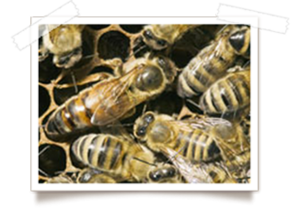Bees

In the beehive perfect work organisation rules.
Bees are remarkable and useful creatures. They are a type of colony-building insect. In the beehive a sophisticated division of labour orders every bee's activities. In winter only around 10,000 bees live in the hive, whereas in summer the population is three to six times as large. Then the colony consists of a queen bee, 30,000 to 60,000 worker bees and 500 to 2,000 drones.
All insects work extremely efficiently together and use an ingenious form of communication. This is the only way for the diligent bees to produce such enormous volumes of delicious and healthy honey. As a sideline they also take care of plant pollination, without which no fruit would be produced.
First lady and mother of all bees
Every beehive only has one queen, also known as the queen bee. She develops from a normal bee larva but is fed exclusively with royal jelly, the special liquid diet for the queen, which is a secretion in the head glands of young bees. With this special substance she attains three times the size of a worker bee. Her life expectancy is three to five years, whereas an ordinary bee only lives 28 days.
Only the queen bee develops ovaries that enable her to perform her most important task. On her one "wedding flight" she mates with up to 20 drones. The semen gathered from this flight is sufficient for laying 3,000 to 5,000 eggs per day for the rest of her life.
Jack of all trades for one summer
The life of a worker bee usually spans four to six weeks of one summer. Only bees that hatch just before winter live longer, and then just for a few months. In their short life, bees must undertake many types of work.
In the first 10 days they clean the brood cells and take care of the new brood. Then they build the honeycomb and guard the entrance hole. During the second half of their lives they leave the beehive to collect nectar, honeydew and pollen.
Pure sperm donors
Drones develop from unfertilised eggs and become somewhat larger than worker bees. They are unable to feed themselves and must be fed by worker bees. Their only task is to mate with the queen bee. That happens during the so-called "wedding flight", but only a maximum of 20 drones strike lucky.
After mating they fall to the ground and die. When the queen bee returns from her wedding flight, the drones have fulfilled their purpose and the remainder are mercilessly slaughtered and thrown out of the hive in August.
Tell me in your dance
Dance skills are needed when a bee tells of a nectar source. If the source is within a 50 metre radius of the hive, she dances in a circle. The more powerful and expressive the dance, the more promising the nectar source.
The others sniff her pollen and begin to look for the matching flowers in the area. For harvest areas that are more than 50 metres distant, the tail-wagging dance comes into play.
The scout bee always dances to the right and the left and moves its abdomen quickly back and forth along the central axis. This axis shows the direction of flight in relation to the sun. The more slowly the bee dances, the more distant is the nectar source.
